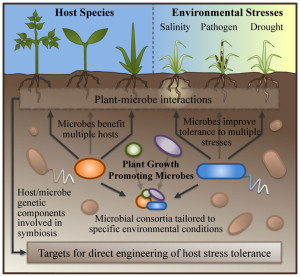Researchers highlight the advantages of promoting beneficial plant-microbe relationships.
The Science:
The usual response to plant stressors such as low nutrient availability and disease has been to breed or develop cultivars that are tolerant or resistant to these concerns. In recent years, researchers have been paying more attention to the interactions between plants and microbial communities and the benefits that plants may receive through these relationships faster than through typical breeding approaches.

Plant-growth promoting microbes are capable of conferring benefits to multiple species of plant hosts, and of offering improved tolerance to multiple stresses simultaneously. (Image from Coleman-Derr at al. Front. Microbiol., 06 June 2014. doi: 10.3389/fmicb.2014.00283)
The Impact:
Due to studies that have focused on root-nodulating bacteria and mycorrhizal fungi, both well-known symbionts that promote plant growth, interest has increased in harnessing these benefits on a larger scale for improving crop yield for fuels and food. A collaboration between crop breeders and researchers in microbial-based crop improvement programs could further speed up the process of boosting crop yields to meet growing global demand.
Summary
Crop breeders are working on ways to boost yields to supply an ever-increasing global population with needed materials for both food and fuels. However, they face challenges such as decreasing arable farmland, drought, disease, and low nutrient availability. The tried-and-true response has been to develop crop strains that are tolerant of such stressors. However, another approach that has gained more attention in recent years has been to find ways of providing plants with needed nutrients or pathogen resistance through their interactions with the surrounding microbial communities. Host-associated metagenomics studies, such as those conducted by researchers at the U.S. Department of Energy Joint Genome Institute (DOE JGI) and their collaborators, consider the relationship between plants and their microbial symbionts as similar to the relationship between the human body and the microbes that reside in, on and around it.
For example, the DOE JGI Fungal Genomics Program is working on a Mycorrhizal Genomics Initiative to understand the associations between microbes and trees in forests and their impact on the carbon cycle and on degrading plant mass. Similarly, a few years ago, the DOE JGI Metagenome Group was part of a team that studied the rhizosphere of the model plant Arabidopsis to understand how plants and microbes influence each other.
In a perspective published June 6, 2014 in Frontiers in Microbiology, DOE JGI Metagenome Program head Susannah Tringe and postdoctoral fellow Devin Coleman-Derr compare plant breeding and symbiont-based approaches involving what are referred to in the paper as plant growth-promoting microorganisms or PGPM. Plant breeding, they noted, is time-consuming, and typically benefits only one species at a time. Applying biotechnology approaches to develop transgenic plants, on the other hand, raises issues such as environmental safety and food regulations.
In contrast, microbial symbionts are not necessarily associated with a single crop or species, so that understanding a community can benefit multiple plants. Also, the symbionts can counter more than one stressor. This is not to say that researchers promoting symbiont-based approaches face no challenges. Though microbial symbionts may benefit multiple crops, this is not necessarily true in all instances. Also, interactions between PGPM and the microbial communities around the crop may change or cancel out the potential benefits.
“In the future, there is a need for more collaboration between the host-focused and symbiont-focused approaches to mitigating abiotic stress in crop plants,” the researchers concluded. “Medical science has in recent years undergone a profound restructuring of its understanding of the microbiome housed within the body and its impact on human health. There is a clear parallel here for plant science…. The fundamental change required is a broader recognition that plants do not exist as autonomous organisms governed entirely by their genetic blueprints, but rather serve as ecological niches for diverse communities of easily overlooked microbes, which work in concert with the plant to survive in a wide range of stressful environmental conditions.”
Contact
Susannah Tringe
DOE Joint Genome Institute
sgtringe@lbl.gov
Funding
- U.S. Department of Energy Office of Science
- National Science Foundation
Publication
Coleman-Derr D et al. Building the crops of tomorrow: advantages of symbiont-based approaches to improving abiotic stress tolerance. Front Microbiol. 2014 Jun 6;5:283. doi: 10.3389/fmicb.2014.00283.